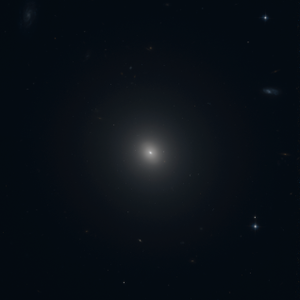NGC 1439
| Galaxy NGC 1439 |
|
|---|---|

|
|
| Image taken by the Hubble space telescope of the galaxy NGC 1439: In the center, a torus can be seen at the limit of the resolution. | |
| AladinLite | |
| Constellation | Eridanus |
|
Position equinox : J2000.0 , epoch : J2000.0 |
|
| Right ascension | 03 h 44 m 49.9 s |
| declination | -21 ° 55 ′ 14 ″ |
| Appearance | |
| Morphological type | E1 |
| Brightness (visual) | 11.4 mag |
| Brightness (B-band) | 12.3 mag |
| Angular expansion | 2.4 ′ × 2.2 ′ |
| Position angle | 27 ° |
| Surface brightness | 13.2 mag / arcmin² |
| Physical data | |
| Affiliation | Eridanus Group LGG 97 |
| Redshift | 0.005571 ± 0.000033 |
| Radial velocity | 1670 ± 10 km / s |
|
Stroke distance v rad / H 0 |
(70 ± 5) · 10 6 ly (21.6 ± 1.5) Mpc |
| history | |
| discovery | William Herschel |
| Discovery date | December 9, 1784 |
| Catalog names | |
| NGC 1439 • PGC 13738 • ESO 549-009 • MCG -04-09-056 • 2MASX J03444995-2155137 • SGC 034239-2204.7 • GC 771 • H III 249 • h 2584 • LDCE 251 NED048 | |
NGC 1439 is an elliptical galaxy from the Hubble type E1 in the constellation Eridanus the southern sky . It is estimated to be 70 million light years from the Milky Way and about 50,000 light years across.
In the same area of the sky are u. a. the galaxies NGC 1414 , NGC 1422 , NGC 1426 .
The object was by astronomer William Herschel using in 1784, a 18.7-inch - telescope discovered.
Web links
Commons : NGC 1439 - collection of images, videos, and audio files
